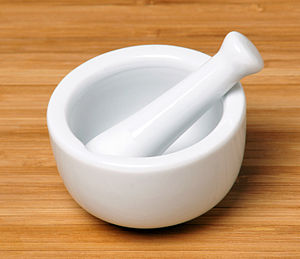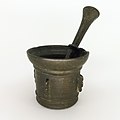Mortar and pestle/ja: Difference between revisions
Created page with "==素材{{Anchor|Material}}== 優れた乳鉢と乳棒を作る素材は、粉砕される物質によって摩耗するのではなく、それを粉砕できるほど硬くなければならない。また、あまりに脆いと、搗いたり挽いたりする際に壊れてしまうので、脆すぎてもいけない。素材は凝集性がある必要があり、乳鉢や乳棒の小さな破片が材料に混ざらないようにしなければならない。滑..." |
Created page with "==利点{{Anchor|Advantages}}== 乳鉢と乳棒、すなわち乳棒で叩き潰すという方法は、物質が低いエネルギーで粉砕されるため、物質が熱くならないという利点がある。" |
||
| (4 intermediate revisions by the same user not shown) | |||
| Line 100: | Line 100: | ||
[[outline of food preparation/ja|食品調理]]において、粗い素材や吸収性の高い素材は、以前に調理した食材の強い風味が後で調理する食品に影響を与えてしまう可能性がある。また、乳鉢や乳棒に残った食品の粒子が微生物の増殖を助けることも考えられる。医薬品を扱う場合、以前に調製された薬剤が相互作用したり混ざったりして、現在使用している材料を汚染する可能性がある。 | [[outline of food preparation/ja|食品調理]]において、粗い素材や吸収性の高い素材は、以前に調理した食材の強い風味が後で調理する食品に影響を与えてしまう可能性がある。また、乳鉢や乳棒に残った食品の粒子が微生物の増殖を助けることも考えられる。医薬品を扱う場合、以前に調製された薬剤が相互作用したり混ざったりして、現在使用している材料を汚染する可能性がある。 | ||
粗いセラミック製の乳鉢と乳棒のセットは、物質を非常に細かい粉末にするのに使えるが、簡単に染色され、脆い。磁器製の乳鉢は、粒子サイズを小さくするのに役立つ粗い表面を与えるために、砂を挽いて使用前に調整されることがある。ガラス製の乳鉢と乳棒は壊れやすいが、染色に強く、液体での使用に適している。しかし、セラミック製ほど細かく挽くことはできない。 | |||
その他に使用される素材には、石(多くは[[:en:marble|大理石]]や[[:en:agate|瑪瑙]])、木材(吸収性が高い)、[[:en:bamboo|竹]]、鉄、[[:en:steel|鋼]]、[[:en:brass|真鍮]]、そして[[:en:molcajete|玄武岩]]がある。古いブドウの木から作られた乳鉢と乳棒のセットは、食卓で塩と胡椒を挽くのに信頼性が高いことが証明されている。乳鉢をきれいにするために、生米が乳鉢で挽かれることがある。この工程は、米が完全に白くなるまで繰り返す必要がある。[[:en:Molcajete|モルカヘテ]]のような一部の石は、使用前に最初に調整する必要がある。金属製の乳鉢は軽く油を塗って保管される。 | |||
==自動乳鉢粉砕機{{Anchor|Automatic mortar grinder}}== | |||
== Automatic mortar grinder == | 手動での粉砕では結果の再現性が低いため、ほとんどの研究室では自動乳鉢粉砕機を使用している。粉砕時間と乳鉢の圧力を調整・固定できるため、時間と労力を節約できる。 | ||
最初の自動乳鉢粉砕機は、1923年にF.クルト・レッチュによって発明され、彼にちなんで「レッチュミル」と名付けられた。 | |||
==利点{{Anchor|Advantages}}== | |||
== Advantages == | 乳鉢と乳棒、すなわち乳棒で叩き潰すという方法は、物質が低いエネルギーで粉砕されるため、物質が熱くならないという利点がある。 | ||
== ギャラリー == | == ギャラリー == | ||
Latest revision as of 12:04, 7 June 2025
 中に乳棒が入ったキッチンモルタル | |
| Uses | |
|---|---|
| Related items | |
乳鉢と乳棒(にゅうばちとにゅうぼう)は、厨房、研究室、薬局で、材料や物質を粉砕したりすり潰したりして、細かいペーストや粉末にするために使われる、2つの単純な道具のセットである。「乳鉢」(/ˈmɔːrtər/)は特徴的にボウル状で、通常は硬材、金属、陶磁器、または花崗岩のような硬い石で作られている。「乳棒」(/ˈpɛsəl/, <small>または</small> US: /ˈpɛstəl/)は鈍く、こん棒のような形をしている。すり潰す物質(湿っていても乾いていてもよい)を乳鉢に入れ、乳棒で叩いたり、押さえつけたり、回転させたりして、目的の質感になるまで処理する。
乳鉢と乳棒は石器時代から料理に使われてきた。今日では、医薬品の調製における歴史的な使用から、薬学の専門職と結び付けられている。化学の現場では少量の化学物質を粉砕するために、芸術や化粧品では顔料、結合剤、その他の物質を粉砕するために、陶芸ではグロッグを作るために、石工や粉砕された材料を必要とする他の種類の建設で使われる。料理では、通常、スパイスを砕いたり、ペストを作ったり、モヒートなどの特定のカクテル(グラスの中で砂糖、氷、ミントの葉を乳棒で軽く砕く必要がある)に使われる。

乳鉢と乳棒の発明は、挽き臼の発明と関連しているようだ。挽き臼は、自然に凹んだ丈夫な硬石の台と、石や木の木槌を使って、叩き、砕き、粉砕し、挽くことで食品や植物材料、粘土、鉱物を加工するという、同様の原理を用いている。
乳鉢の重要な利点は、平らな挽き石で起こるような無駄やこぼれがなく、粉砕する材料を閉じ込めるためにより深いボウルを提供することである。もう一つの利点は、乳鉢を人が直立して隣に立ち、上半身と重力の組み合わせた力を使ってより良く搗くことができるほど大きく作れることである。大きな乳鉢は、複数の乳棒を持つ数人が、より速く効率的に材料を搗くことを可能にする。人が隣に立って作業できる大きな乳鉢は、かがんで不快で反復的な手によるすり潰し運動をスライドさせて行う小さな挽き臼よりも、物理的に楽でより人間工学的である(全身のより良い姿勢を確保できるため)。
乳鉢と乳棒は、現代のブレンダーやグラインダーに先行し、電気や燃料を必要としない小型で移動可能な手動式ミルとしての機能を持つと言える。
大きな木製の乳鉢と木製の乳棒は、新石器時代に家畜の家畜化と乳製品の使用が乳鉢と乳棒よりもかなり後になってから始まったため、バターチャーンの発明に先行し、それにつながっただろう。バターは、木製の容器に入ったクリームや牛乳を、長い木の棒で攪拌して作られ、これは木製の乳鉢と乳棒の使用と非常によく似ている。
歴史


乳鉢と乳棒は石器時代に発明された。人々が食べ物や様々な他の材料を粉砕してより小さな粒子に加工することで、利用が改善され、様々な利点が得られることを発見したときである。硬い穀物は、最初に粉砕すればより簡単に調理・消化でき、土器の破片をグロッグに粉砕すれば焼き粘土が大幅に改善され、塩の塊のような大きな物体ははるかに扱いやすくなった。様々な石製の乳鉢と乳棒が発見されているが、木製や粘土製のものは時間の経過とともに遥かに容易に朽ち果ててしまう。
科学者たちは、紀元前約35000年に遡る古代の乳鉢と乳棒を南西アジアで発見している。
石製の乳鉢と乳棒は、ケバラン文化(レバントとシナイ半島)によって紀元前22000年から18000年にかけて穀物や他の植物材料を粉砕するために使用されてきた。発見されたケバランの乳鉢は、多孔質の石で彫られたわずかに円錐形のボウルで、乳棒はより滑らかな種類の石で作られている。
もう一つの石器時代の例は、イスラエルのラケフェト洞窟にある岩石乳鉢である。これは洞窟の床にある自然のくぼみで、紀元前約10000年に後期ナトゥーフ文化の人々がくぼみの中でビールを醸造するために穀物を挽くのに使用した。これらの岩石乳鉢は、人がその隣に直立して立ち、長い木製の乳棒でくぼみの中の穀物を砕くのに十分な大きさである。
古代アフリカ人、シュメール人、エジプト人、タイ人、ラオス人、ポリネシア人、ネイティブアメリカン、中国人、インド人、ギリシア人、ケルト人、その他数えきれないほどの人々が、料理、芸術、化粧品、簡単な化学薬品、陶磁器、医薬品の材料や物質を加工するために乳鉢と乳棒を使用した。
14世紀以降、特に錬金術や初期の化学での使用において、青銅製の乳鉢が石製のものよりも人気が高まった。青銅製の乳鉢は石製のものよりも精巧になり、より硬いという利点があり、持ち手や握り玉、注ぎ口を簡単に鋳造することができた。しかし、大きな欠点は、青銅が酸や他の化学物質と反応して容易に腐食することであった。17世紀後半以降、釉薬をかけた磁器製の乳鉢は、化学物質によって損傷せず、掃除が簡単であるため、非常に有用になった。
語源
英語の「mortar」は、中英語の「morter」、古フランス語の「mortier」を経て、古典ラテン語の「mortarium」に由来する。このラテン語は、「潰すための容器」や「挽いたもの、潰したもの」といった意味を持ち、サンスクリット語の「mrnati」(潰す、砕く)と関連があるかもしれない。
古典ラテン語の「pistillum」(「叩くもの」の意)が、英語の「pestle」につながった。このpistillumに由来して、イタリア料理のペストという言葉は、乳棒で作られたものを意味する。
ローマの詩人ユウェナーリスは、「mortarium」と「pistillum」の両方を薬の調合に使われる品物に適用した。これは、乳鉢と乳棒が薬剤師や薬屋の象徴として早期から使用されていたことを示している。
石工のセメントの同義語としての「mortar」は、セメントを作る材料をすり潰すために乳鉢と乳棒が使われていたことに由来する。短砲身の臼砲は、フランス語で「mortar」と呼ばれていた。これは、これらの大砲の初期のものが中世の大きな金属製の乳鉢のように見え、乳鉢が粉末状の物質で満たされるように、火薬で満たす必要があったためである。
文化と象徴における乳鉢と乳棒

乳鉢と乳棒の古さは、紀元前約1550年のエジプトのエバース・パピルス(現存する最古の医学文献)や旧約聖書(民数記11章8節、箴言27章22節)などの初期の著作に明確に記録されている。
インド神話では、バーガヴァタ・プラーナの「サムドラ・マンタン」で、乳棒で大海を攪拌して不死の甘露「アムリタ」が作られる。
中世以来、乳鉢は薬剤師や医師の墓石に置かれたり、彫られたりしてきた。
ロシアや東欧の民間伝承では、バーバ・ヤーガは大きな木製の乳鉢(ストゥーパ)の中に立って森の中を飛び、片手には目の前の障害物を取り除くための長い木製の乳棒を持ち、もう一方の手には自分の痕跡を消すための箒を持って飛んでいると描写され、絵に描かれている。これは、バーバ・ヤーガの魔女の象徴と、中世の無学な人々にはすべて魔法と見なされていた錬金術、薬学、初期の化学における乳鉢の使用を結びつける、古代の儀式の痕跡であると思われる。
様々なアジアの神話や民間伝承には、乳鉢と乳棒を使って「不老不死の薬」(または餅を作るための米)の材料を加工する月のウサギという共通のテーマがある。
現代の薬局、特にドイツでは、今でも乳鉢と乳棒をロゴとして使用している。
用途
医学

乳鉢と乳棒は、調合薬を調製する前に様々な材料を砕くために、薬局で伝統的に使用されてきた。乳鉢と乳棒は、アスクレピオスの杖、緑の十字などと並んで、薬学の最も広く普及している象徴の一つである。
製薬用途では、乳鉢と乳棒の頭部は通常磁器でできており、乳棒の柄は木材でできている。これはウェッジウッドの乳鉢と乳棒として知られており、1759年に誕生した。今日では、材料を混ぜ合わせたり、粒子サイズを小さくしたりする行為はトリチュレーションとして知られている。
乳鉢と乳棒は、薬物器具としても使用され、経口摂取時の吸収を速めるために錠剤を粉砕したり、経鼻摂取の準備のために使用される。液体剤形で入手できない微粉砕された薬剤も、経静脈栄養や経鼻胃管による人工栄養を必要とする患者の場合に利用される。
食材の調理


乳鉢は、ワカモレ、フムス、ペスト(その名前は乳棒で潰すことから派生している)などの湿った、または油っぽい食材の調理にも使われる。また、スパイスを粉末に挽くのにも使われる。モルカヘテは、アステカやマヤ文明を含む先スペイン期のメソアメリカ文化で数千年前から使われてきたもので、玄武岩製で、メキシコ料理で広く使用されている。他のアメリカ先住民の部族は、岩盤に彫られた乳鉢を使ってドングリやその他のナッツを挽いた。このような窪みは彼らの居住地域で多く見られる。
日本では、餅を作るのに非常に大きな乳鉢と木製の杵が使われる。通常のサイズの日本の乳鉢と乳棒は、それぞれ「すり鉢」と「すりこぎ」と呼ばれる。花崗岩製の乳鉢と乳棒は東南アジア、パキスタン、インドで使われている。インドでは、様々な珍味や日常の料理のためのスパイス混合物を作るのに広く使われている。電動グラインダーの出現により、乳鉢と乳棒の使用は減少した。様々なヒンドゥー教の儀式(結婚式やウパナヤナムなど)では、これらの乳鉢でターメリックを砕くのが伝統である。
マレー語では「batu lesung」として知られている。西アジアでは、長い(2〜3フィート)木製の乳棒を持つ大きな石製の乳鉢が、ある種のミートローフやキッベ、またマサバチャとして知られるフムスを作るために肉を挽くのに使われた。インドネシアでは、乳鉢は「Cobek」または「Tjobek」、乳棒は「Ulekan」または「Oelekan」として知られている。コベックは深い受け皿または皿のような形をしている。ウレカンはピストルの形か卵形である。これはしばしば新鮮なサンバル、辛いチリ調味料を作るのに使われるため、「sambal ulek/oelek」はその乳棒を使ったプロセスを意味する。また、ガドガド用のピーナッツソースを作るために、ピーナッツやその他の材料を挽くのにも使われる。
籾殻と脱穀

発展途上国では、穀物の籾殻や脱穀に、依然として大きな乳鉢と乳棒が一般的に使用されている。これらは通常木製で、一人または複数の人が操作する。
フィリピンでは、乳鉢と乳棒は特に米の籾殻取りと関連付けられている。注目すべき伝統的な乳鉢と乳棒は、船の形をした「bangkang pinawa」または「bangkang pangpinawa」であり、文字通り「精白されていない米のための船(バンカ)」を意味し、通常はモラベやその他の硬材のブロックから彫り出される。これは2、3人で搗いて使用される。この乳鉢の名称である「lusong」は、フィリピン最大の島であるルソン島の名前の由来となっている。
西アフリカでは、何世紀にもわたって大きな木製の乳鉢と乳棒が穀物の脱穀に使われてきた。奴隷にされたアフリカ人がアメリカ大陸に連れてこられた際、彼らはこの技術とその使用法に関する知識を持参した。ミドルパッセージの間、一部の奴隷船は籾殻のついた米を積んでおり、奴隷にされたアフリカ人女性は、消費のためにそれを準備するために乳鉢と乳棒を使う任務を負っていた。植民地時代の北アメリカと南アメリカの両方で、機械式製粉機が普及し始めた1700年代半ば頃まで、米は主にこの方法で手で製粉され続けていた。
素材
優れた乳鉢と乳棒を作る素材は、粉砕される物質によって摩耗するのではなく、それを粉砕できるほど硬くなければならない。また、あまりに脆いと、搗いたり挽いたりする際に壊れてしまうので、脆すぎてもいけない。素材は凝集性がある必要があり、乳鉢や乳棒の小さな破片が材料に混ざらないようにしなければならない。滑らかで非多孔性の素材が選ばれ、粉砕される物質を吸収したり閉じ込めたりしないようにする。

食品調理において、粗い素材や吸収性の高い素材は、以前に調理した食材の強い風味が後で調理する食品に影響を与えてしまう可能性がある。また、乳鉢や乳棒に残った食品の粒子が微生物の増殖を助けることも考えられる。医薬品を扱う場合、以前に調製された薬剤が相互作用したり混ざったりして、現在使用している材料を汚染する可能性がある。
粗いセラミック製の乳鉢と乳棒のセットは、物質を非常に細かい粉末にするのに使えるが、簡単に染色され、脆い。磁器製の乳鉢は、粒子サイズを小さくするのに役立つ粗い表面を与えるために、砂を挽いて使用前に調整されることがある。ガラス製の乳鉢と乳棒は壊れやすいが、染色に強く、液体での使用に適している。しかし、セラミック製ほど細かく挽くことはできない。
その他に使用される素材には、石(多くは大理石や瑪瑙)、木材(吸収性が高い)、竹、鉄、鋼、真鍮、そして玄武岩がある。古いブドウの木から作られた乳鉢と乳棒のセットは、食卓で塩と胡椒を挽くのに信頼性が高いことが証明されている。乳鉢をきれいにするために、生米が乳鉢で挽かれることがある。この工程は、米が完全に白くなるまで繰り返す必要がある。モルカヘテのような一部の石は、使用前に最初に調整する必要がある。金属製の乳鉢は軽く油を塗って保管される。
自動乳鉢粉砕機
手動での粉砕では結果の再現性が低いため、ほとんどの研究室では自動乳鉢粉砕機を使用している。粉砕時間と乳鉢の圧力を調整・固定できるため、時間と労力を節約できる。
最初の自動乳鉢粉砕機は、1923年にF.クルト・レッチュによって発明され、彼にちなんで「レッチュミル」と名付けられた。
利点
乳鉢と乳棒、すなわち乳棒で叩き潰すという方法は、物質が低いエネルギーで粉砕されるため、物質が熱くならないという利点がある。
ギャラリー
-
ギリシャ製の青銅合金製乳鉢と乳棒
-
エチオピアで作られるミトミタ
-
ネパールの伝統的な乳鉢と乳棒
-
モルカヘテとテホロテ、メキシコ
-
ラオス式の乳鉢と乳棒
-
植物を粉砕するために使用される乳鉢
-
木製の乳鉢と乳棒
関連項目
外部リンク
| この記事は、クリエイティブ・コモンズ・表示・継承ライセンス3.0のもとで公表されたウィキペディアの項目Mortar and pestle(23 February 2025, at 17:39編集記事参照)を翻訳して二次利用しています。 |










